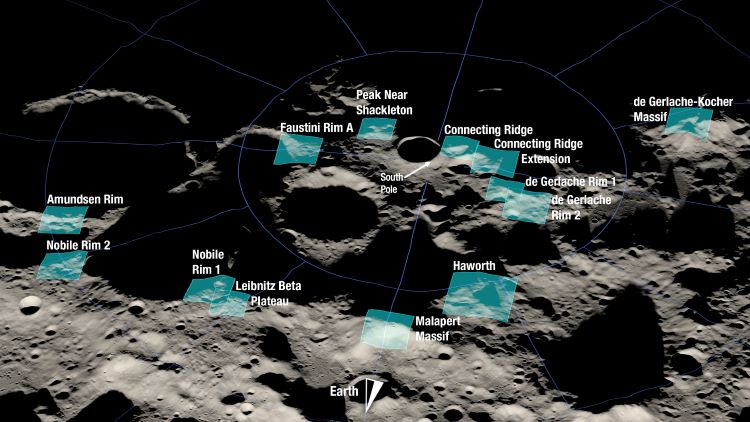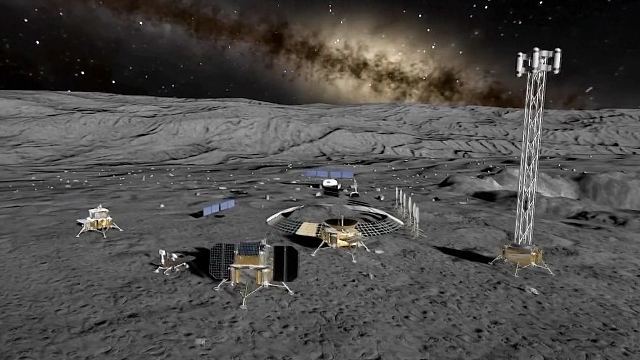China’s Chang’e-7 Will Deploy a Hopper that Jumps into a Crater in Search of Water Ice
By Laurence Tognetti
Researchers from the Chinese Academy of Sciences and the Chinese National Space Administration recently published a study in the journal Space: Science & Technology outlining how the upcoming Chang’e-7 mission, due to launch in 2026, will use a combination of orbital observations and in-situ analyses to help identify the location, amount, and dispersion of water-ice in the permanently-shadowed regions (PSRs) of the Moon, specifically at the lunar south pole.
Once the orbiter successfully achieves lunar orbit, it will deploy the lander and mini-flying probe designed to perform in-situ analyses of lunar water-ice while the orbiter is expected to conduct remote observations using a variety of instruments.
The paper discusses how the mini-flying probe, which will be equipped with a water molecular analyzer to collect lunar surface frost water molecules, will be capable of flying from the sunlit regions on the lunar south pole to the dark bottom of the impact craters within the PSRs. The mini-flying probe will also include a drilling tool, mechanical arm, and heating furnace for conducting spectral analyses of lunar water-ice, as well. An enormous benefit to the mini-flying probe will be its ability to travel to the bottom of impact craters, which conventional lunar rovers were never designed to do. The paper states the goal of the mini-flying probe’s analyses will be to hopefully identify water, ammonia, and additional volatiles at the bottom of these PSR craters.
While Chang’e-7 isn’t currently scheduled to launch until 2026, Chang’e-6 is scheduled to land on the far side of the Moon sometime in 2024 to collect samples and return them to Earth, which could serve as a systems test prior to Chang’e-7’s arrival in 2026. This will lead to the Chang’e-8 mission in 2028, which will work with Chang’e-7 in conducting experiments on in-situ resource utilization, or ISRU, with the goal of constructing an International Lunar Research Station. All these missions are a part of China’s ambitious blueprint for lunar robotic and human exploration, with the goal of landing Chinese astronauts on the Moon by 2030.
The reason lunar water-ice is so heavily pursued is its promise for helping establish a sustained human presence on the Moon, along with aiding in deep space human exploration, specifically to Mars. This is because combining ISRU with the presence of lunar water-ice will significantly reduce the need for constant resupply from Earth, which could reduce cost, time, and resources in sending water to the Moon.
There are several PSR impact craters at the lunar south pole that are current targets for water-ice exploration, specifically Shackleton Crater, which partially resides directly on the Moon’s south rotational pole. Its crater bottom has been permanently in the dark for billions of years, with only its mountainous rim being permanently bathed in sunlight. Despite this, portions of Shackleton’s interior were recently imaged in high-resolution by NASA’s ShadowCam, which is onboard Korea Pathfinder Lunar Orbiter from the Korea Aerospace Research Institute. ShadowCam has 200 times the light-gathering power than NASA’s Lunar Reconnaissance Orbiter Narrow Angle Camera, known for its high-resolution images of the lunar surface.
Along with China, the United States is amid its own rigorous human lunar exploration program with NASA’s Artemis, whose goal is to land the first woman and person of color on the lunar surface for the first time, along with being the first that humans will have set foot on the Moon since Apollo 17 in 1972. Like Chang’e-7, this historic landing is set to take part at the lunar south pole with the Artemis III mission, currently scheduled to take place in 2025, with NASA recently identifying 13 potential candidate landing sites at the south pole.

How will China’s ambitious lunar exploration program play out in the nest few years, and will Chang’e-7 be successful in exploring the PSRs on the south pole of the Moon in preparation for future human landings? Only time will tell, and this is why we science!
As always, keep doing science & keep looking up!
The post China’s Chang’e-7 Will Deploy a Hopper that Jumps into a Crater in Search of Water Ice appeared first on Universe Today.

August 4, 2023 at 07:57AM
via Universe Today read more...

Post a Comment